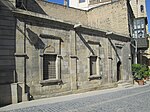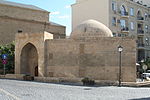Muhammad Mosque

Muhammad Mosque or Siniggala Mosque is the mosque built in the 11th century in Old City, Baku, Azerbaijan. The mosque is also known as Siniggala, after the name of its minaret – Siniggala (“damaged tower”). The mosque acquired its second name in 1723, when military squadron of Russian Army, consisting of 15 warships and led by Admiral Matyushkin, approached the city from seaside and demanded its surrender during the Russo-Persian War (1722-1723). Russian warships began to bomb the city after the refusal to surrender. One of the Russian shells hit the minaret of Muhammad Mosque and damaged it. A stormy wind then blew the Russian ships further out to sea. The population of the city interpreted the wind as a divine scourge sent to the occupants. From that time until the middle of the 19th century, the minaret of the mosque wasn’t reconstructed. It remained a symbol of the persistence and courage of the defendants of the tower.It is the first building in Azerbaijan, which is related to Islam and dated for its architectural ligature.
Excerpt from the Wikipedia article Muhammad Mosque (License: CC BY-SA 3.0, Authors, Images).Muhammad Mosque
Aziz Aliyev street, Baku City
Geographical coordinates (GPS) Address Nearby Places Show on map
Geographical coordinates (GPS)
| Latitude | Longitude |
|---|---|
| N 40.365277777778 ° | E 49.834722222222 ° |
Address
İçəri şəhər
Aziz Aliyev street
1095 Baku City (Sabail Raion)
Baku, Azerbaijan
Open on Google Maps










